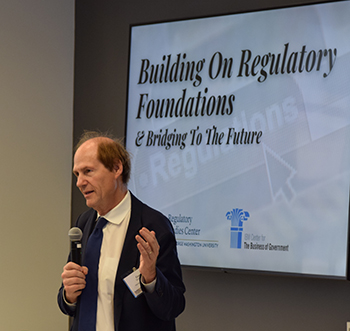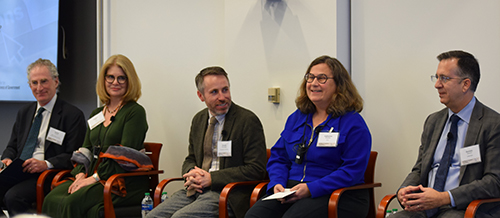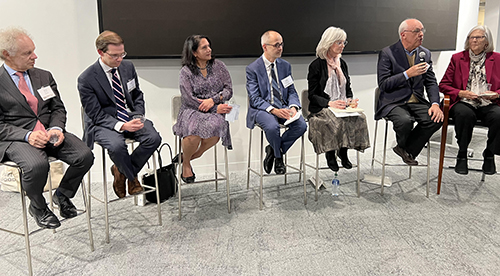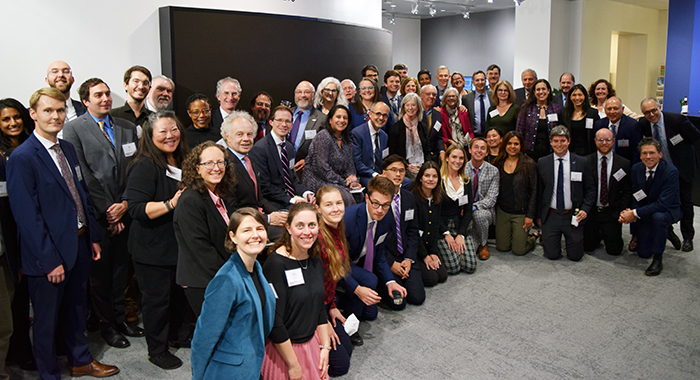
Event Highlights: Building On Regulatory Foundations and Bridging to the Future

Two more recent, but no less important, foundations are Executive Order 12866 of 1993 and Circular A-4 of 2003. In November, the IBM Center for the Business of Government and the George Washington University Regulatory Studies Center gathered regulatory experts to reflect on these foundations and explore emerging opportunities and challenges for good regulatory practice.
Daniel Chenok, director of the IBM Center for The Business of Government, and Susan Dudley, director of the GW Regulatory Studies Center welcomed the 100+ participants and introduced keynote speaker, Cass Sunstein (pictured upper-left) of Harvard Law School. Sunstein focused his remarks on what he calls “sludge,” the often-unnecessary red tape that can reduce efficiency and limit access to government services.
 Chenok led a panel (pictured left) discussion that featured Don Moynihan (Georgetown University), Catherine Sharkey (New York University), Dominic Mancini (Office of Information and Regulatory Affairs), and Virginia Huth (General Services Administration). Sharkey’s research into how agencies use AI to improve their ex-post evaluation of regulations offered interesting illustrations. For example, the Food and Drug Administration is now able to rely more on ex-post monitoring of new drug effects, rather than relying on reports of adverse events. Mancini observed that agencies are issuing fewer regulations, but that some of those have very large impacts and generate thousands of public comments, which challenges agencies’ capacity to respond effectively. Rulemaking records are getting more complex, a trend which may be expected to continue if recent judicial trends continue.
Chenok led a panel (pictured left) discussion that featured Don Moynihan (Georgetown University), Catherine Sharkey (New York University), Dominic Mancini (Office of Information and Regulatory Affairs), and Virginia Huth (General Services Administration). Sharkey’s research into how agencies use AI to improve their ex-post evaluation of regulations offered interesting illustrations. For example, the Food and Drug Administration is now able to rely more on ex-post monitoring of new drug effects, rather than relying on reports of adverse events. Mancini observed that agencies are issuing fewer regulations, but that some of those have very large impacts and generate thousands of public comments, which challenges agencies’ capacity to respond effectively. Rulemaking records are getting more complex, a trend which may be expected to continue if recent judicial trends continue.
Following these introductory remarks, participants divided into five breakout sessions for more in-depth discussions of the following topics:
- Engaging the public for more responsive regulation. This session, led by George Washington University political science professor, Steven Balla explored how emerging technologies could affect public engagement in rulemaking, and the threats and opportunities of generative AI.
- Is OIRA still fit for purpose? Ohio State University law professor, Bridget Dooling led a session exploring OIRA’s role in today’s government and considering whether OIRA is well-positioned to fulfill its various missions into the future.
- Generative AI applications to rule development & evaluation. This session was led by David Bray, Distinguished Fellow at the Stimson Center and Andy Fois, Chair of the Administrative Conference of the United States. It addressed several questions. How should the government get ahead of issues involving the intersection of GenAI and other algorithmic tools in rule development and evaluation, and what are federal administrative agencies are already doing? What are the beneficial uses and risks? How will the Presidential Executive Order of October 30th,2023 on AI and AI Safety, as well as the follow-up draft OMB guidance to agencies for its implementation, shape additional steps in 2024 and beyond.
- Improving evidence for prospective & retrospective policy analysis. Nick Hart, president of the Data Foundation explored how we can leverage Circular A-4 and the Foundations for Evidence-Based Policymaking Act to encourage more retrospective evaluation for regulations.
- Agile regulation. Michael Fitzpatrick, Brunswick Group used the National Academy of Public Administration (NAPA)’s recent report as the basis for this breakout discussion. NAPA offered nine tenets for an Agile Regulatory Framework to help federal agencies meet public needs in an increasingly fast-paced and dynamic environment, marked particularly by rapid and impactful technology change.
The sessions were conducted under Chatham House rules. Summaries of the key discussion topics for each breakout session are forthcoming.
 After each group reported their key findings for discussion to the full assembly, participants gathered for a reception that honored the 30th and 20th anniversaries of Executive Order 12866 and Circular A-4, respectively. Current and former OIRA Administrators (pictured left) representing each of the last five administrations gave brief toasts, reflecting the durability and nonpartisan nature of regulatory practice. Participants heard from Ricky Revesz (Biden), Paul Ray (Trump), Neomi Rao (Trump), Boris Bershteyn (Obama), Susan Dudley (Bush 43), John Graham (Bush 43), and Sally Katzen (Clinton).
After each group reported their key findings for discussion to the full assembly, participants gathered for a reception that honored the 30th and 20th anniversaries of Executive Order 12866 and Circular A-4, respectively. Current and former OIRA Administrators (pictured left) representing each of the last five administrations gave brief toasts, reflecting the durability and nonpartisan nature of regulatory practice. Participants heard from Ricky Revesz (Biden), Paul Ray (Trump), Neomi Rao (Trump), Boris Bershteyn (Obama), Susan Dudley (Bush 43), John Graham (Bush 43), and Sally Katzen (Clinton).




